Search: Clearing 3 Rucks
Maul and Ruck - Clearing the Ruck
Clearing the tackle area with pace relies on committed support. Clearance rucking is a dynamic method of restarting the attack if the defence has managed to create a breakdown.
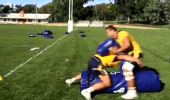 8:10
8:10
Ruck Clearing and Decision Making
Advanced clearing exercises for senior players. The support player makes a decision on how to clear out the ruck based on the position of the opposition.
3. Ruck Touch
To watch over 2500+ videos join now for free!
JOIN NOW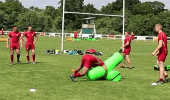 4:55
4:55
Ruck Clearing Exercises
Two crucial clearance techniques - the saddle roll, and the duck and clean. It's important for players to practice these at length, under pressure, under fatigue, and with an element of decision-making in order to best re-create a match situation.

Women's - Accurate clearing of players 3
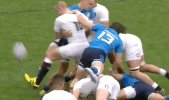 3:27
3:27
Breakdown - Clear & Kick
Teach your players how to kick the ball at the ruck. With players sometimes reluctant to give away penalties this technique is a great way to turnover the ball and stay on your feet
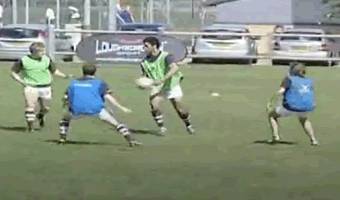 4:30
4:30
Small-side game - Ruck Touch
There are many versions of ruck touch with the support players needing to recognise the needs of the tackled player.
The defence should be conditioned to provide increasing pressure to the tackle area. This will develop the situation recognision of the attacking players who must play accordingly. Robotics in rucking regardles of the situation should be discouraged and the option of picking upthe ball and going forward should be an option
 2:18
2:18
USA Sevens - Learn The Rules Of The Ruck
With less players the breakdown is much cleaner in Seven's and knowing the laws and being accurate in your skills wins matches. Mike Friday clarifies what can be a complex area and why many coaches focus on this facet of the game
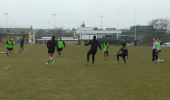 2:59
2:59
Quins Defence - Tackling in units 3 v 3
This exercise is part of a tackle technique progression and pitches 3 attackers v 3 defenders. As in match play the attacking players will present different challenges to the defenders. The coaches can choose to alter the conditions to put more or less pressure on the players
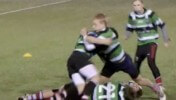 3:31
3:31
Ruck touch - Focus on rolling players away
A key technique at the breakdown is the ability to roll players away, this applies when your opponent already has a good body position over the ball. Danny Wild from Leeds carnegie uses a game and breakout sessions to deliver his session
Step 5 - Introducing the 3 v 3 Scrum
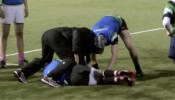 1:49
1:49
Decision making at the breakdown - Ruck touch
Coaching players to make the right decision at the breakdown is a complex challenge for coaches. In this video Danny Wild from Leeds carnegie uses a whole - part - whole approach to help improve the players decision making
Maul and Ruck - Under 13s and 14s Ruck
Training through traditional drills does not develop game understanding and players often become robotic in their behaviour
Conditioned games promote game understanding and encourage players to recognise the needs at any given situation
The drill should be used only to refine technique and the danger is to develop players that act without game understanding
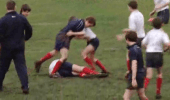 2:17
2:17
Ruck Touch Rugby
Coaches can use games to introduce all skills for your age group. If you are very specific about the conditions you apply then players will learn these skills in a fun and enjoyable game
QBE - Ruck Touch
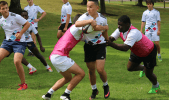 4:43
4:43
Rucking - Live With 5
A clever and competitive practise using 5 players that involves passing, tackling and then making the crucial decision of what to do at the breakdown. This can be done from Under 12's upwards
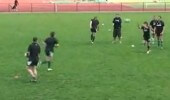
Passing 4 v 3 reset
A progression from 2 v 1 , 3 v 2 to 4 v 3
Maul and Ruck - U9 Coaching
Notice how these players do not naturally set up rucks. Both teams try to keep the ball away from breakdown situations.
What would these games look like if the coaches stepped in and insisted on rucking?
 0:42
0:42
Junior - Accurate clearing of players 1
Junior - Accurate clearing of players
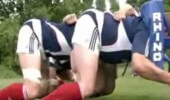 0:56
0:56
Lions - 3&5 man scrum practice
A progression from the 3 man scrum - developing body shape and positions
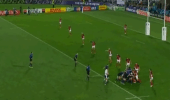 0:23
0:23
Men's - Lineout maul good defence 3
Men's - Lineout maul good defence 3
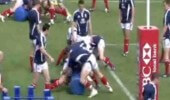 1:03
1:03
British Lions - tackle then Jackal then clear out
Many of these drills require repetition, here we see how the importance of good body shape in contact can be practiced as both the jackler and those clearing out the tackle
 0:51
0:51
Women's - Patterns of Play 3
Women's - Patterns of Play 3
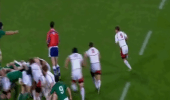 0:27
0:27
Men's - Strike Moves 3
Men's - Strike Moves 3
 0:24
0:24
Men's - Exiting the 22m 3
Men's - Exiting the 22m 3
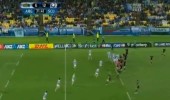 0:19
0:19
Men's - 3 v 2 1
A passage of play that shows how to attack with more attackers than defenders, a 3 v 2. The winger shows that strong running and determination can break tackles. Click on the practises in this section for coaching ideas
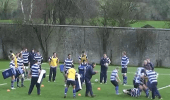 1:00
1:00
Rucking Zone
A tiring exercise of continuous rucking. Encourage your players to maintain good standards even when tiring and highlight the importance of getting straight up after one breakdown to make another.
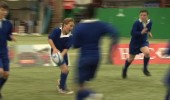 0:26
0:26
3 v 2 in Channel
A development of the 2 v 1 and 3 v1 drills, the attackers now must beat 2 defenders. This requires more decision-making ability as the movements of the defenders could change every time. Players must communicate as well as continue to perform their handling and running skills.
Maul and Ruck - Under 10s and 11s Mauling
Notice how the tackled player often remains on their feet and a mass of pulling and pushing begins
When a player is taken to the ground, the supporting players try to pick the ball up. There is not a natural inclination to ruck
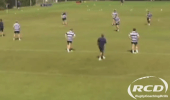 0:51
0:51
Attacking progression's 4 v 3
A progression from 3 v 2s, this drill is closer to a game situation, where there are more decisions for the attacking players to make. The gaps could appear in a variety of locations and they have several passing /running options. With 4 attacking players, you may wish to utilise your basic strike moves.
Maul and Ruck - Maul Gain Lines
With the maul, the gain line is fluid and the defence can be forced onto the back foot
With the ruck, the gain line is static and the defence are often set and on the front foot
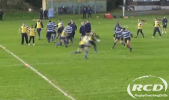 0:46
0:46
3 v 2 and then another defender
Develop decision-making skills in attack. 3 attackers must beat 2 defenders, before facing a third immediately after.
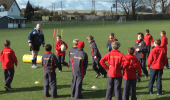 2:15
2:15
Passing - 3 v 2 Live Defenders
Gradually progress from 2 static defenders, to 3 v 2 roaming defenders. The first two players must draw their defenders before giving the pass.
 0:15
0:15
Women's - 2 v 3 1
Women's - 2 v 3 1
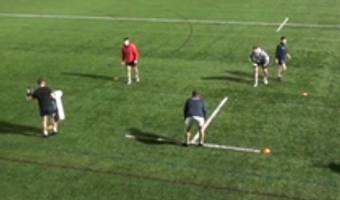 1:06
1:06
Contact Square - Inside Clear
All attacking players need to fix their opposite defender.
 1:29
1:29
Andy Farrell's 3 Top tips For Defence
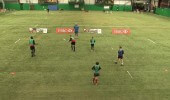 0:28
0:28
3 v 1 in Channel
A progression from the 2 v 1, where a second pass is encouraged to move the ball away from the defender.
Step 3 - Introducing the 1 v 1 Scrum
 3:14
3:14
The Importance of Basic Breakdown Skills
Continuously we see that the best teams are those that perform the basic skills better than their opponents. Basic skills such as passing, catching, running, tackling, and rucking. The breakdown is an essential element to the game as teams look to control momentum. Mastering the basic rucking and clearing techniques gives many teams the edge, and the quick ball that is required to enable their attack.
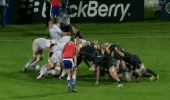
Men's - Wheeled Scrums 3
An example of a wheeled scrum
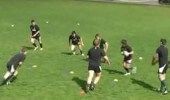
4 v 3 after 5m reset
Core skills training
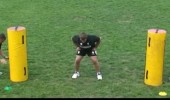 0:06
0:06
3-man lifting practice with pads
Progress lifting practises with more movement as is required in matches. The coach can alter things to make the exercise easier or more demanding. Key factors : Communication - Fast feet - Straight back - Squat / bend the knee's - Lock out arms
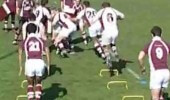 0:21
0:21
6 v 2 v 2 v 2 v 3
Developing the skills into decision making down a channel
Infringements Clip 3 - Cynical Play
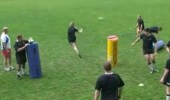 0:26
0:26
Tackle bag drill 3 man support after tackle
This is a very effective drill for developing decision making and awareness in support runners off a tackle situation
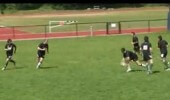 0:13
0:13
Attacking in waves of 3
The ability to realign quickly is important to developing the back play and counter attacking. Coaches can vary the numbers and timing of the first pass to make this exercise easier or more demanding. Key factors : Run straight - Comunicate early - Uniform distance and depth - Catch & pass in one movement - Hips straight - Hands & armes across the body - Realign quickly - Aerobic fitness
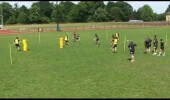 0:54
0:54
Change the point of attack - 4 v 3
This drill allows you to develop decision making by varying the attack and defence continually thus accelerating learning
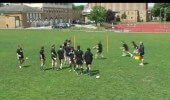 0:33
0:33
3 v 2 in channel
A good progression from the 2 v 1 drill
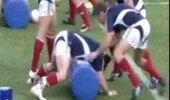 0:47
0:47
Lions 09 - Clearing the tackler away
With the new adjustments around the tackle zone, what variation would you adopt now so that this drill is now legal?
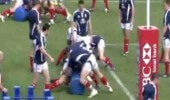
British Lions - tackle then jackal then clear out
This technique proved so successful they adjusted the rules to prevent its use, what was the rules change and can you coach it?

Men's - Accurate clearing of players 2
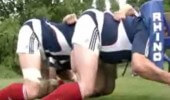 0:23
0:23
Lions 09 - 3-man Scrum Practice
Develop the front row as a foundation for the building of the scrum
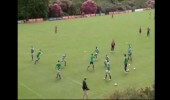 1:04
1:04
Lions 09 Backs defence 3
A clip with a progression on defensive systems from the 2009 Lions Tour
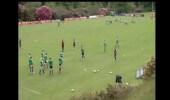 0:33
0:33
Lions 09 Backs support lines 3
Lions 2009 support drills, with a progression
Materiality Clip 11 - Ruck Management
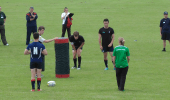 1:27
1:27
Turnover session - Clearing
Breaking down the turnover situation into separate technical elements, players can work on their essential skills.
Here, in a series of progressions, the emphasis is on the first defender to arrive at the breakdown. They should attack the breakdown and fight to get through and past the ball.
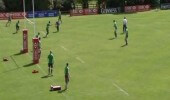 0:14
0:14
Lions 09 - backline defence inown 22 option 3
Where you are on the pitch can determine you defensive system
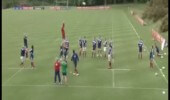 0:23
0:23
Lions 09 lineout 3
Lineout variation and practice
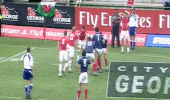 0:38
0:38
Sevens - Full Lineout 3
Accurate skills are the key to lineouts in seven's, a combination of movement, lifting and throw combine to make an effective restart for the attacking team. The shape of the attacking side is pre planned to create a mis - match with a faster player v a slower one. key factors : Pre call the move - Fast feet - Strong core for jumper - Support from both players to lift the jumper - Jumper to jump - Accurate throw - Support he jumper to the ground - Offload pass to scrum half
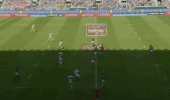 1:14
1:14
Sevens - Patterns of Play 3
Working in units and working through phases is crucial to modern day sevens and in this clip the White team show great technique and patience to work their way up the field to score. Key factors : Ball retention - Communication - Work in units - Accurate passing - Patience - Stamina
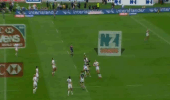 0:28
0:28
Sevens - Standard restart with attack winning ball 3
A well organised re start with one main attacker challenging for the ball with support both in front and behind him, if the ball is knocked either side of the main catcher the ball will be gathered by his teammates. Great leg drive to continue the attack and a very long pass to complete the scoring. Key factors : Accurate kick - Focus on the ball - Sideways jump - Catch ball above head - Structured support
Maul and Ruck - Practice Relevance
Consider the relevance of each practice
Make practices as realistic to the game as possible in order to maximise the learning process
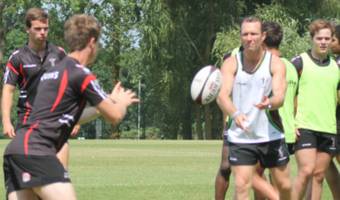 3:05
3:05
3 v 2 How to Fix Defenders
Running straight & fixing defenders is a skill that all players must learn and learn at an early age. The top players regularly practise this skill to maintain accuracy. This is the building block to scoring tries
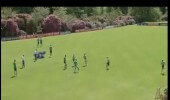 0:07
0:07
Lions 09 Strike Moves 3
Developimg attack plays through the backs
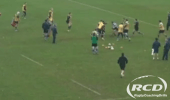 1:03
1:03
Fringe Attack - Pop and Ruck
Attacking close around the fringe can minimise risk of losing the ball and can help turn slow ball into quick ball, putting the defence on the back-foot.
 0:08
0:08
Defence - 3. Press Up and Out
This illustration is an up-and-out system and not a drift
This relies on the defenders continuing to press forward, closing the space as they shadow the attacking players
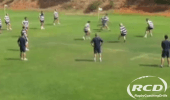 1:19
1:19
3 v 2 attacking practice
A useful drill to build decision-making skills. Attackers must choose from a variety of running and passing options.
1. Support - 1,2,3 Follow Through
Isolated technical practice
Courtesy of the SRU
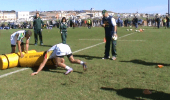 2:06
2:06
Breakdown - Accurate Rucking
This series of clips shows how conditioning and good technique are crucial to be effective at the breakdown. The progressions are simple and the key coaching points are Low to high body position Strong leg drive Accuracy on the target - The tackle bag
 1:13
1:13
Fitness - Reptile crawls for rucking
Fitness exercises to help players improve their effectiveness in contact are very popular at present. Jack Crehan talks through this exercise and demonstrates how it should be done
3. Support - Colour Reaction Drill
Isolated technical practice
Courtesy of the SRU
Maul and Ruck - Maul Slide Drive
In this technique, the ball is constantly being shifted so the point of pressure is moving and challenging the defence
Maul and Ruck - Youth Maul
The maul can be a fast method of retaining the ball. It commits more defenders. It can continue to gain ground. The dangers are when forwards and backs are separated in practice and the back-line players do not understand their role at the maul, or even back away from the contest.
Maul and Ruck - Misunderstanding the breakdown
Training through traditional drills does not develop game understanding and players often become robotic in their behaviour
Conditioned games promote game understanding and encourage players to recognise the needs at any given situation
The drill should be used only to refine technique
Maul and Ruck - Practice Relevance
Consider the relevance of each practice
Make practices as realistic to the game as possible in order to maximise the learning process
3. Half Back Play Continued
A scrum half needs good vision, speed and awareness, quick hands and lightning reactions. The scrum half is the key link between the forwards and the back line. A good scrum half will know how to vary the play and take advantage of any opportunity that the opposition may offer
The fly half is the heart beat of the side and should be a key influence on the way the team plays the game. Almost every attack will go through the fly half, so they need to develop tactical awareness, accurate passing, kicking accuracy, vision, leadership and resilience
Maul and Ruck - Maul Leg Drive
Staying on the feet and maintaining aggressive leg drive, can be very difficult to defend
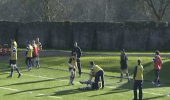 0:51
0:51
Support play in 3s, Offload and ruck
Practice the different options in recycling the ball. A lot of the time, the ball will be tied up and an offload won't be on. Develop this drill by allowing the players to call how the ball should be played, and for their teammates to react.
Good Practice - Segment 3
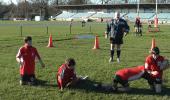 0:37
0:37
Tackling on Knees - 3 v 1
Using three attackers ensures the defender tackles on both sides and from slightly different angles. The coach can vary the pace and width of this exercise
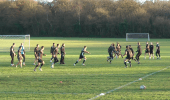 1:43
1:43
Broncos 4 - 6 v 3 Identify space
Players to attack with "Heads up" and identify where colleagues have space. Supporting players to call early to the ball carriers. Defenders to stay tight to not let attack through the middle spaces easily
Scrum Factory - 3. TOP With Rugby Balls
Expensive training equipment is not necessary and the simple rugby ball can provide an excellent technical and conditioning work out
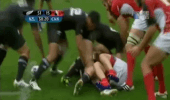
Men's - Accurate clearing of players 1
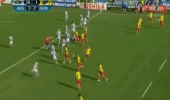 0:20
0:20
Men's - 3 v 2 2
Level 2 - Back Row Example Clip 3

Men's - Classic tackle 3

Men's - Wrap Tackle 3

Men's - Leg Drive 3
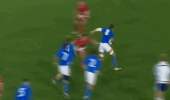 0:40
0:40
IRB Men's - Offloads 3
A quick lineout allows players to attack a "broken field" defence. Running at space moves the defenders and the suport player comes from depth behind the attacker to score. Key factors : Loud communication - Accurate spin pass - Attacking space - Trail support - Pop pass - Quick running

Men's - Turnover and move the ball 3

Men's - Clips of Coaches 3
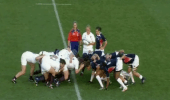
Women's - Straight Scrums 3
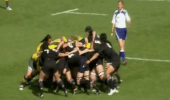
Women's - Wheeled Scrums 3

Women's - Offloads 3

Women's - Accurate clearing of players 1

Women's - Accurate clearing of players 2

Women's - Turnovers and move the ball 3

Women's - 2 v 3 2
 0:23
0:23
Men's - Patterns of play 3
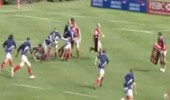
British lions - team play 3
team play practice in a semi-opposed style assists the players in learning their roles and responsibilities

